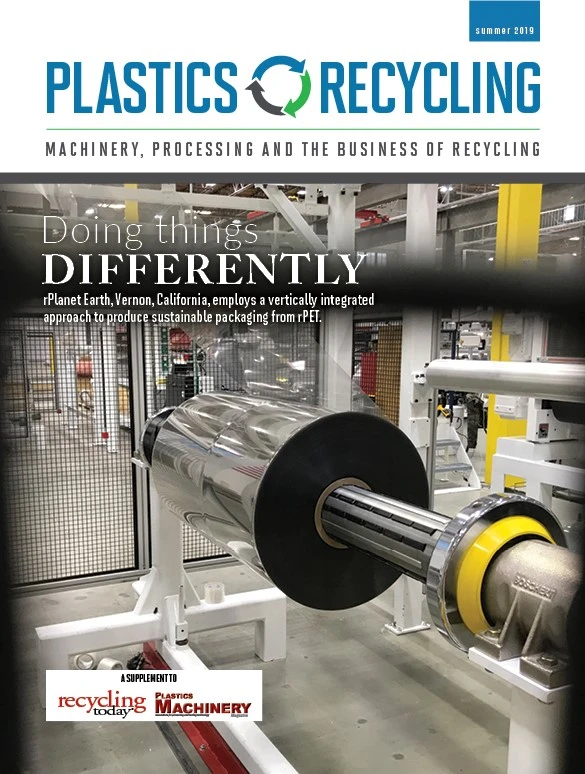Resin purification. A French partnership has received a patent for a process that removes impurities from postconsumer polyolefins, with the goal of making them suitable for use in automotive parts that require high-quality surface finishes.
The patent, which was issued to Compagnie Plastic Omnium, Lyon, France, three French universities and a government research organization, describes an extruder with a vacuum pump to remove impurities, such as volatile organic compounds and dissolved salts, from ground postconsumer polyolefins, preferably polypropylene (PP).
“These pollutants … are produced during the life of the polymer under the action of degradation due to aging, temperature, light and external pollutions such as engine oils or contaminations of any kind,” according to the patent. “They are present not only on the surface but also within the polymer to be recycled, trapped and/or dissolved in the entanglement of the polymer chains. This explains why simply washing the ground materials is not sufficient to remove them and why extraction is required.”
Postconsumer resins with such impurities are unacceptable for making painted automotive parts because they can contaminate paint lines, the patent states, leading to flawed finishes.
The postconsumer resin is mixed in the extruder with a liquid or mixture of liquids, such as water, liquid nitrogen or alcohol, before vacuum extraction and pelletizing, according to the patent.
Patent 10,189,970; issued Jan. 29
Postconsumer resin. A patent issued to a Mumbai company describes recycled resin formulations specifically tailored for manufacturing multilayer extruded tubes containing a high percentage of postconsumer plastic. It also covers the tubes’ manufacturing process.

The patent, issued to Essel Propack Ltd., describes a polymer comprising between 80 percent and 95 percent recycled high-density polyethylene (HDPE), with the balance consisting of one or more specialized additives to improve seal strength, resistance to environmental stress cracking and other characteristics of the recycled resin.
The finished tube consists of three layers: two layers composed primarily of recycled HDPE and a virgin HDPE layer that is in contact with the tube’s contents.
The invention could help divert postconsumer plastics from landfills and save petroleum-based raw materials, according to the patent.
Patent 10,214,639; issued Feb. 26
Pyrolysis. A process for increasing the yield of petrochemicals derived from treating mixed plastics in a pyrolysis reactor has earned a patent for Saudi Basic Industries Corp., Riyadh, Saudi Arabia. The plastics can include PE, PP, polyurethane, polyester, filled polymers, composites, plastic alloys and rubber.
The process incorporates a separator to dechlorinate the plastic before entering the reactor. In the reactor, the plastics are converted into a gaseous stream and a liquid stream, which undergo further processing in a hydrocracking unit, significantly boosting the yield of petrochemicals, the patent states.
Patent 10,233,395; issued March 19
Sorting. Unisensor Sensorsysteme GmbH, Karlsruhe, Germany, has patented an apparatus that sorts free-flowing bulk recyclable plastics and has a higher throughput than equipment that employs conveyor belts or an inclined feed mechanism while maintaining a similar footprint.
The system has a silo that empties onto conveyors centered inside the directing apparatus, which is a cone-shaped structure. The conveyors propel the material outward in a 360-degree arc to fall along the inner wall of the directing apparatus.
Centered under the directing apparatus is an optical-scanning device that rotates a light beam at up to 12,000 rpm, so it intersects with the falling material stream that surrounds it. The reflected light is analyzed by a process spectrometer.
A first set of containers is arrayed in a ring below the bottom edge of the directing apparatus. Compressed-air nozzles are positioned along the edge of the first set of containers. The spectrometer identifies individual fractions that should be sorted from the main stream and directs the appropriate nozzles to divert each targeted fraction into a second set of containers arrayed in a ring outside the first ring of containers.
Patent 10,245,621; issued April 2
Get curated news on YOUR industry.
Enter your email to receive our newsletters.
Explore the June 2019 Plastics Recycling Issue
Check out more from this issue and find your next story to read.
Latest from Recycling Today
- MTM Critical Metals secures supply agreement with Dynamic Lifecycle Innovations
- McClung-Logan Equipment Company joins Tana’s authorized dealer network
- Grede to close Alabama foundry
- Plastics Recycling Conference 2025: Working toward their targets
- SWACO rolls out new commercial recycling and food waste programming
- Updated: Matalco to close Canton, Ohio, plant
- Metso launches electric Anode Weighing and Casting Machine
- Circular by Shapiro releases '5 for Five' sustainability series






